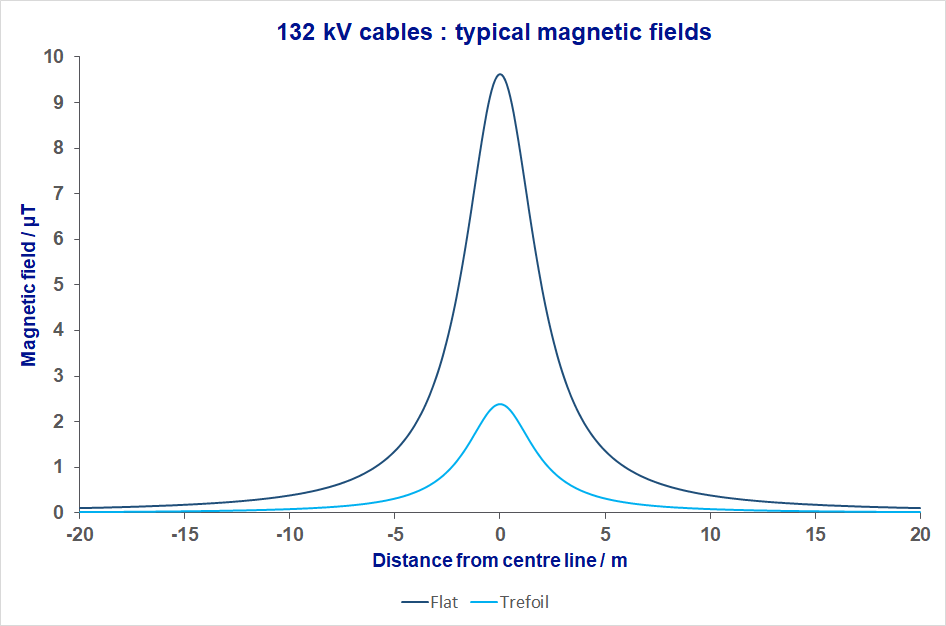Distribution cables
Distribution cables cover a range of voltages from 132 kV to 11 kV. These cables can have various designs which leads to different levels of magnetic fields. On this page typical levels of magnetic field from 132 kV and 11 kV cables are given but the exact fields from any specific cable will depend on the design and the way that it operates.
The maximum fields from the largest 132 kV cable are given below. This demonstrates that even for the maximum possible field for a distribution cable, the public exposure guideline level is not exceeded and therefore these cables are always compliant.
Often 132 kV cables have three cable per circuit, which can be arranged in a flat formation or in a triangular formation, known as a trefoil formation. In general the closer the cables are the smaller the magnetic fields, because the magnetic fields from each cable cancel each other to a degree.
The following graph shows typical fields for these two types of cable designs.

Table of magnetic fields from typical 132 kV undergound cables
| Magnetic field | Distance from centre line | |||
|---|---|---|---|---|
| 0 m | 5 m | 10 m | 20 m | |
| Separate cables - flat formation | 9.62 μT | 1.33 μT | 0.38 μT | 0.10 μT |
| Separate cables - trefoil formation | 2.38 μT | 0.32 μT | 0.09 μT | 0.02 μT |
| Magnetic field public exposure limit |
360 μT |
|||
At 11 kV underground cables are usually a single cable: the three cores are twisted round each other in a single outer sheath. Because the cores are so close together and twisted, the fields they produce directly are very small. Instead, the field comes from any net current in the sheath. This is very variable and cannot be predicted accurately.
The following graph shows typical fields from the net current in a 11 kV cable.

Table of fields from the same cable.
| Magnetic field | Distance from centre line | ||||
|---|---|---|---|---|---|
| 0 m | 5 m | 10 m | 20 m | ||
| Single cable | 0.5 m depth | 0.75 μT | 0.22 μT | 0.11 μT | 0.06 μT |
| Magnetic field public exposure limit |
360 μT |
||||
The largest magnetic fields produced by 132 kV cables are where the individual cores are physically furthest apart and when they carry the maximum current.
Underground cables are not constructed to specific designs as overhead lines are so each one is potentially slightly different. Therefore, a hypothetical design that has the cores separated by more than any practical cable would, and which carries a larger load than any practical cable would, has been used to calculate the maximum possible magnetic field. If this hypothetical design is compliant then any practical design, which will produce lower fields, will also be compliant. This hypothetical design could be operated at any voltage, as the magnetic field depends only on the current and the geometry, not on the voltage.
The design chosen has cores separated by 1 metre, buried 1 metre below ground, and carries a load of 1000 A per phase. A graph and table of the magnetic field that this cable would produce are given below.
Table of fields from the same cable.
| Magnetic fields | Distance from centre line | ||||||
|---|---|---|---|---|---|---|---|
| 0 m | 5 m | 10 m | 20 m | 30 m | 50 m | ||
| Seperate cores (flat formation) |
1 m spacing 1 m depth |
72 μT | 12 μT | 3.4 μT | 0.9 μT | 0.4 μT | 0.1 μT |
| Magnetic field public exposure limit |
360 μT |
||||||